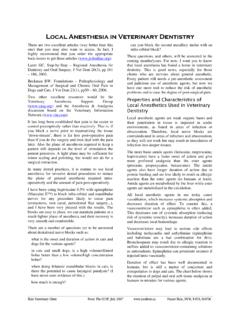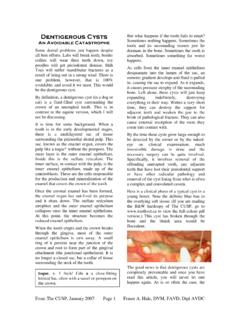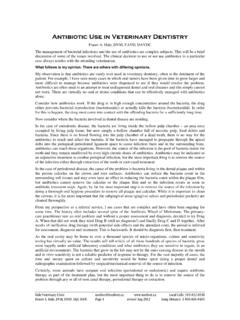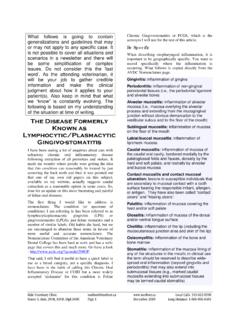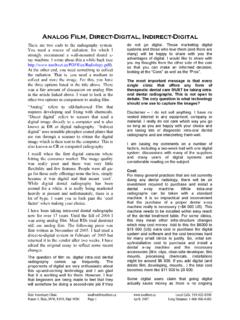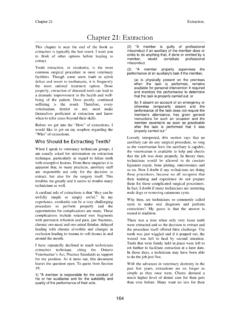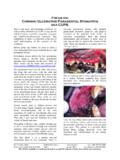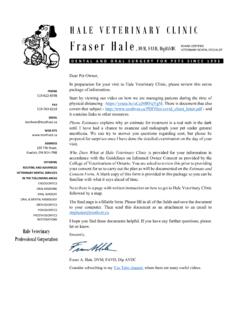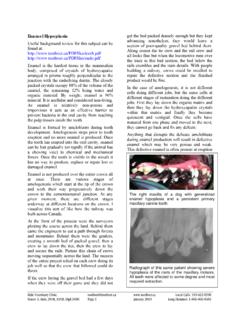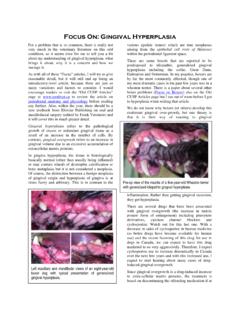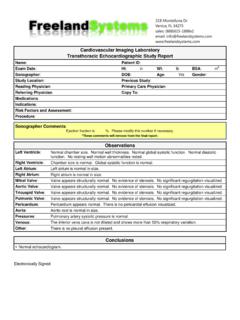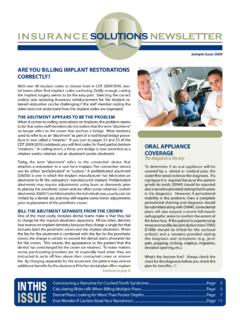Transcription of Chapter 8: Equipment - Fraser Hale
1 Chapter 8 Equipment . 42 Chap ter 8: Eq uipmentPeriodontal Probe/Explorer The periodontal probe/explorer has been described as the most important dental instrument. In fact, it has been suggested that if you do not have one, you should lock away all your dental instruments until you get one. The reason for this fervor over such a simple implement is that, without one, you cannot accurately assess problems below the gum line, which is where most of the trouble lies. This applies to the pre-treatment assessment as well as to monitoring your progress intra-operatively.
2 As you can see, one end has a blunt tip on a straight arm. This probe is graduated in some way to act as a ruler. The probe is gently introduced into the gingival sulcus and slowly advanced to the floor to measure the depth of the sulcus. The probe is then retracted a millimeter or so, moved along the tooth a few millimeters and re-advanced. The process is continued until the probe has been walked or hopped all the way around each tooth, taking several measurements on each. In this way, you will discover many deep periodontal pockets that you might otherwise have missed.
3 Probing can easily damage the junctional epithelial attachment to the tooth and create a defect where none existed before. This not only causes disease but will lead to an over-estimation of the degree of disease present which could lead to inappropriate treatment planning. When probing, 20 grams of pressure is suggested. This can be practiced by placing the tip of the probe against your thumbnail and pushing just hard enough to cause blanching. Pushing your probe harder than this will not only give inaccurate results, but will also create damage to the very tissues we are trying to help.
4 The other end of the instrument has what is known as a Shepherd's Crook. This fine, sharp tipped explorer has several uses. After root planing, the explorer is introduced subgingivally and gently dragged across the surface of the root. Any irregularities such as residual calculus, diseased cementum or pits in the dentin will be detected as the fine tip transmits the vibrations up to the shaft of the instrument and into your hand. The principle is the same as with the phonograph needle, for those old enough to remember what they were.
5 No other instrument in your kit will be as sensitive for this crucial application. You would not send a fracture patient home without first taking a post-operative radiograph, and you should not start polishing the teeth until you have thoroughly explored the sulci to ensure that the roots are smooth and clean. Some dentists prefer to use the probe end for subgingival exploration, feeling that the sharp explorer is potentially too damaging to the sulcar and junctional epithelium. The explorer is also useful for detecting small subgingival resorptive lesions ( neck lesions ) in cats.
6 In dogs, caries (cavities) will often start in the occlusal fossae of the first upper molars. Visually, they might appear as brown staining, Figure # A periodontal probe/explorers. The end to the left is the periodontal probe, which has a blunt tip and a graduated end. It is used as an intra-oral ruler to measure the depth of periodontal pockets or anything else. The end to the right is the shepherd s crook dental explorer, used for detecting caries, resorptive lesions, pulp exposures and other dental abnormalities.
7 Chapter 8 Equipment . 43 but when explored more closely, you will feel the difference. With staining of enamel, you cannot get the explorer to stick in. If there is a caries lesion, you will be able to force the tip into the softened dentin, and when you withdraw, there will be a tugback. When you see a cusp that is worn down or broken off, you will be curious to know if the injury extends into the pulp chamber. Here again, this fine tip on the explorer is a big help. Run the tip over the suspect area and if you can get it to drop into a hole, you know the pulp is exposed and that the tooth needs endodontic therapy or extraction.
8 I have often used an explorer in the examination room to demonstrate to skeptical clients that there really is a hole in a tooth. Remember that in most cases, by the time you see the tooth, the coronal pulp is already dead and so the animal will not feel your probing. If red pulp is visible, do not stick the explorer in, as this will cause great pain. Probes also make good pointers to show clients other problems in the mouth while allowing you to keep your fingers from obscuring the view. I suggest you order a probe/explorer for each exam room and one for each dental kit.
9 Having previously practiced with only one, I found that it was seldom where I needed it. I cannot guess how much time was wasted and how many miles were traveled trying to find my probe. Probe/explorers are available from any human dental supply house and a growing number of veterinary catalogues. I would look for one with a fine explorer end as some on the market are too thick to transmit minute vibrations effectively. Prices will range from about $ to $ Scalers and curettes When it comes to scaling, many of us are very dependent on our mechanical aids.
10 An ultra-sonic scaler can be found in almost every practice. Although these machines can speed up the removal of supragingival calculus, the hand instruments must not be over looked. Figure # Probe ends. The instrument on top is a Sensor Probe. It is advanced into the sulcus and when it meets 20 grams of resistance, the end bends back so that the gap closes. This helps the operator to develop the light touch needed for safe and accurate probing. The Sensor Probe and probe below are graduated by alternating light and dark bands 3 millimeters wide each.
